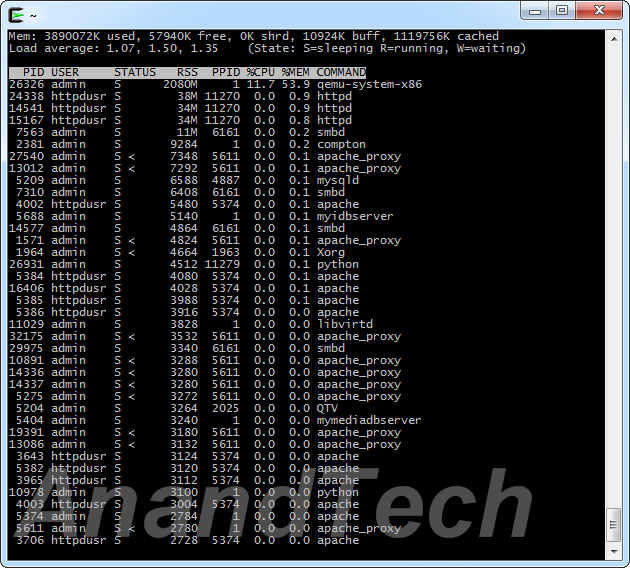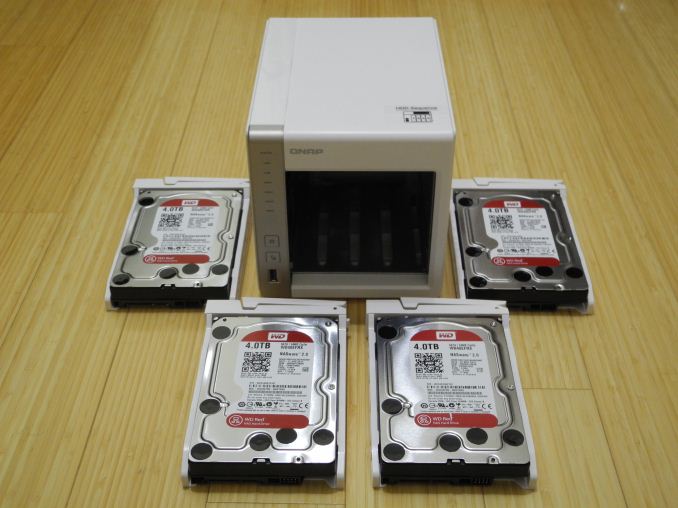NAS Units as VM Hosts: QNAP's Virtualization Station Explored
by Ganesh T S on August 18, 2014 10:15 AM EST- Posted in
- NAS
- Storage
- Virtualization
- QNAP

Introduction
Virtualization Platforms - A Brief Background
Virtualization has been around since the 1960s, but it wasn't till Intel and AMD started introducing hardware acceleration features that the feature started gaining mainstream focus outside enterprise applications. In addition to several applications in the enterprise space, virtualization has also started to lower the cost of IT infrastructure even for SMBs (think in terms of virtualized Exchange servers and similar applications). However, does the current state of virtualization offer any applications / benefits to home users? What are the ways in which regular users can take advantage of it? The answer to the second question is partly provided by QNAP's Virtualization Station package in the TS-x51 series. The answer to the first question will decide whether the Virtualization Station package can offer compelling enough benefits for users to choose the QNAP TS-x51 series over competing models from other vendors.
Put simply, the virtualization concept that we are discussing today refers to the creation of computing resources that exist 'virtually' - i.e, independent of the underlying hardware infrastructure. Most commonly, the creation of a virtual machine (VM) implies the setting up of a computer (guest machine) on certain hardware resources (host machine) such that the software / OS being run on the VM is separated from the host's hardware resources. An example could be the setting up of a Linux distribution as a VM on a computer running Windows as the host OS. Software developed for Linux can be run on the VM. The combination of hardware and software on the host machine which enables the creation and running of VMs is called as the hypervisor.
Hypervisors come in two flavours: bare-metal and hosted. While bare-metal solutions install directly on the hardware (VMware ESXi, Citrix XenServer and Microsoft Hyper-V), hosted ones run on top of a host OS. As examples of the latter, we have Oracle VM VirtualBox, QEMU and Hyper-V for Windows. QNAP's Virtualization Station is also a hosted hypervisor. It is based on QEMU (determined by taking a look at the running processes in the QNAP TS-451 with a VM active). We have already looked at the performance aspects of the TS-451 in an earlier review.
QEMU powers almost all of the Linux-based virtualization technologies. It takes advantage of the hardware-level support in processors (an additional reason why QNAP's Virtualization Station is supported only on models with CPUs supporting VT-x capabilities).
Readers interested in learning more about virtualization (particularly from a SMB / SME viewpoint) can peruse our articles focused on that market segment. In the rest of this write-up, we will take a detailed look at QNAP's Virtualization Station, followed by a hands-on report of how it works in the TS-451. One of the unique features of QTS 4.x is the support for SMB 3.0. We take this opportunity to evaluate SMB 3.0 support in the process of determining the performance impact of running a VM on the TS-451. We will also talk about power consumption numbers in the concluding section. Prior to all that, we take a look at the testbed infrastructure for evaluating performance as well as long term usage.
Performance Evaluation Setup
The QNAP TS-451 can take up to four drives. The benchmarks presented later in this review are with the unit configured in RAID 5 using four Western Digital WD4000FYYZ RE drives as the test disks.
| AnandTech NAS Testbed Configuration | |
| Motherboard | Asus Z9PE-D8 WS Dual LGA2011 SSI-EEB |
| CPU | 2 x Intel Xeon E5-2630L |
| Coolers | 2 x Dynatron R17 |
| Memory | G.Skill RipjawsZ F3-12800CL10Q2-64GBZL (8x8GB) CAS 10-10-10-30 |
| OS Drive | OCZ Technology Vertex 4 128GB |
| Secondary Drive | OCZ Technology Vertex 4 128GB |
| Tertiary Drive | OCZ Z-Drive R4 CM88 (1.6TB PCIe SSD) |
| Other Drives | 12 x OCZ Technology Vertex 4 64GB (Offline in the Host OS) |
| Network Cards | 6 x Intel ESA I-340 Quad-GbE Port Network Adapter |
| Chassis | SilverStoneTek Raven RV03 |
| PSU | SilverStoneTek Strider Plus Gold Evolution 850W |
| OS | Windows Server 2008 R2 |
| Network Switch | Netgear ProSafe GSM7352S-200 |
The two ports of the TS-451 were link aggregated in 802.3ad LACP to create a 2 Gbps link for the cases in which no VM was active. In the active VM case, one of the network ports gets dedicated to the VM, while the other is reserved for NAS use. Our performance evaluation testbed configuration is outlined above.
Long Term Evaluation Setup
Usage of WD Re drives and Netgear's GSM 7352S switch make sense for benchmarking purposes, but hardly reflect the general use-case of the QNAP TS-451.
In order to simulate day to day usage, we utilized four WD Red hard drives in a RAID-5 configuration. The performance, as expected, doesn't scale up to what can be obtained with the Re drives, but that is hardly required for most applications of the TS-451.
Thank You!
We thank the following companies for helping us out with our NAS testbed:
- Thanks to Intel for the Xeon E5-2630L CPUs and the ESA I-340 quad port network adapters
- Thanks to Asus for the Z9PE-D8 WS dual LGA 2011 workstation motherboard
- Thanks to Dynatron for the R17 coolers
- Thanks to G.Skill for the RipjawsZ 64GB DDR3 DRAM kit
- Thanks to OCZ Technology for the two 128GB Vertex 4 SSDs, twelve 64GB Vertex 4 SSDs and the OCZ Z-Drive R4 CM88
- Thanks to SilverStone for the Raven RV03 chassis and the 850W Strider Gold Evolution PSU
- Thanks to Netgear for the ProSafe GSM7352S-200 L3 48-port Gigabit Switch with 10 GbE capabilities.
- Thanks to Western Digital for the four WD Re hard drives (WD4000FYYZ) and four WD Red hard drives (WD40EFRX) to use in the NAS under test.












38 Comments
View All Comments
Marthisdil - Monday, August 18, 2014 - link
Except be cheap - when you could build a "server" out of a desktop PC that can do a lot of the same stuff, for less money.deeceefar2 - Monday, August 18, 2014 - link
I could, and have done that in the past. But for MUCH more time invested and with many more support head aches. I use at least 1/2 of all of the features of this box, and I challenge you to build a system that does that for significantly less money using similar power draw without spending months configuring and maintaining it.isa - Monday, August 18, 2014 - link
A thoughtful article overall, so thank you Ganesh. I especially focused on the "power user application scenarios". I get #3 and #1, but #2 baffles me. Why must I run ubiquity's apps in a VM? Since that app comes in apple/win/linux flavors, can't one just download the appropriate version for one's NAS and run it without a VM? Why is a VM required to run Ubiquity or any other home automation app if it's offered in a version compatible with my NAS's OS?ganeshts - Monday, August 18, 2014 - link
Does the NAS vendor provide support for unofficial packages? Most vendors I have talked to wash their hands off all warranties / support once you start messing around in SSH. To be frank, for the average user, it is quite easy to mess up the NAS installation (particularly when the extraneous package they want to install comes with a big train of dependencies).isa - Monday, August 18, 2014 - link
Good points, and I agree.Oyster - Monday, August 18, 2014 - link
Ganesh, awesome work. Thanks for listening to the feedback and covering these details. Very well done article.For your next, can you please cover a showdown between Synology and QNAP OSes (including features like apps, VPN, etc.)?
Arnok666 - Saturday, October 17, 2015 - link
+1shodanshok - Monday, August 18, 2014 - link
Hi Ganesh, thank you for the good review.However, I strongly disagree on the chosen Raid level: if you want to run a virtual machine at full speed, you should really use Raid10 rather then Raid5. The problem with Raid5 is that typical 4KB random writes will trigger full stripe read/modify/write, which will lead noticeable slower VM performance.
I personally faced off this very problem some time ago, with a custom Linux mdraid build running some (5+) VMs: switching to Raid10 drastically boosted performance.
Regards.
ganeshts - Monday, August 18, 2014 - link
Thanks for the note. Most consumers buying the TS-451 are looking for optimal balance of performance and capacity. With 4x 4 TB drives, RAID-5 gives 12 TB of effective storage, while RAID-10 gives 8 TB. I agree that in performance sensitive use-cases, the appropriate RAID level must be chosen.Another reason for choosing RAID-5 is that it typically has the worst performance (along with RAID-6) making it a good test of stressing the I/O and other platform capabilities of different NAS models. All our NAS reviews use RAID-5 for comparative benchmarking even though it might not be a suitable RAID level for a particular application.
tuxRoller - Monday, August 18, 2014 - link
So, xen but not kvm? You're doing your reader a disservice by ignoring the third most popular virt platform.